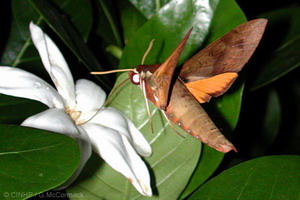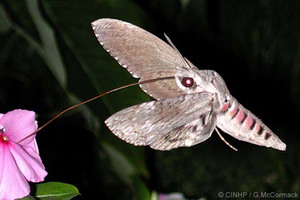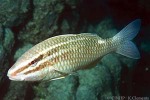Cook Islands Natural Heritage Articles
Hummingbirds in the Cook Islands?
Sometimes in the evening bird-like creatures hover over flowers while probing them with a long slender beak. Are they hummingbirds?
Although they look like the hummingbirds of books and films these creatures are actually large moths, known as hawk-moths or sphinx-moths. They have strong slender wings enabling them to fly very fast and to hover. They are nocturnal feeders, usually starting around dusk. Their caterpillars are called hornworms, because they have a long horn on the rear end.
In the Cook Islands there are three species of hawkmoth, while from Samoa westward there are additional species, including the Taro Hawkmoth, which is a pest on Wetland Taro.
 Our most commonly seen hawkmoth is the large brown Gnathothlibus erotus - wow, what a name. Unfortunately this large moth (to 5cm long) does not have an English name. It is our only hawkmoth with a white stripe from the eyebrow along the sides of the thorax, so we might call it the White-brow Hawkmoth.
Our most commonly seen hawkmoth is the large brown Gnathothlibus erotus - wow, what a name. Unfortunately this large moth (to 5cm long) does not have an English name. It is our only hawkmoth with a white stripe from the eyebrow along the sides of the thorax, so we might call it the White-brow Hawkmoth.
The White-brow Hawkmoth is found from India eastward across the South Pacific to Pitcairn Island. It is often attracted to lights at night, and is sometimes treated as an omen, or messenger from the spirit world. Its Māori names include ‘Iriano, ‘Irianu, Mū, Kiona, Kikiona, and Manu Tāmate Mōrī.
The White-brow Hawkmoth rests with its wings roof-like. It is brown with yellow hindwings, and white legs. Its hornworm is usually green with a yellow stripe along the sides linking a series of white spots with dark edges. The hornworm is usually found feeding on Indian Mulberry, known on different islands as Nono, Nano, Noni, Nenu, or Nonu.
 Our other large hawkmoth is mainly a pest on Sweet Potato (Kūmera) and is known in the tropical Pacific as the Sweet-potato Hawkmoth. This moth is common from French Polynesia westward through Asia to western Europe, and in Eurasia it is called the Convolvulus Hawkmoth. It is also in New Zealand, where one tradition has it arriving on the waka Aotea - along with the Kūmara, Karaka, Kiore and Pūkeko.
Our other large hawkmoth is mainly a pest on Sweet Potato (Kūmera) and is known in the tropical Pacific as the Sweet-potato Hawkmoth. This moth is common from French Polynesia westward through Asia to western Europe, and in Eurasia it is called the Convolvulus Hawkmoth. It is also in New Zealand, where one tradition has it arriving on the waka Aotea - along with the Kūmara, Karaka, Kiore and Pūkeko.
The Sweet-potato Hawkmoth is light grey with darker marks and spots. It is about 5cm long, and its tongue is exceptionally long - about twice as long as its body.
Our third hawkmoth is the Hummingbird Hawkmoth. This is our smallest hawkmoth, about 3cm long. It is native from Indonesia and tropical Australia eastward to at least the Cook Islands.
The Hummingbird Hawkmoth is brown, with yellow and black hindwings. It looks more like a hummingbird than its two relatives, because the rear end has tail-like bristles. Its caterpillar is brown or green. It is a common pest on Indian Mulberry (Nono).
First published in the Cook Islands News, 15 June 2002.
About Gerald McCormack
 Gerald McCormack has worked for the Cook Islands Government since 1980. In 1990 he became the director and researcher for the Cook Islands Natural Heritage Project - a Trust since 1999.
He is the lead developer of the Biodiversity Database, which is based on information from local and overseas experts, fieldwork and library research. He is an accomplished photographer.
Gerald McCormack has worked for the Cook Islands Government since 1980. In 1990 he became the director and researcher for the Cook Islands Natural Heritage Project - a Trust since 1999.
He is the lead developer of the Biodiversity Database, which is based on information from local and overseas experts, fieldwork and library research. He is an accomplished photographer.
Citation Information
McCormack, Gerald (2005) Hummingbirds in the Cook Islands?. Cook Islands Natural Heritage Trust, Rarotonga. Online at http://cookislands.bishopmuseum.org. ![]()
Please refer to our use policy
